
- Science & Technology Notes for UPSC IAS Prelims
- Home
- Science & Technology – Introduction
- Role of Science & Technology in Today’s Life
- Role of Science & Technology In India
- India: Development of Science & Technology
- Science & Technology Policy in India
- Information Technology
- Elements: Information Technology
- Cyber Crime & Cyber Security
- E-Infrastructure in India
- Artificial Intelligence
- Communication Technology
- Space Science & Technology
- Biotechnology
- Nanotechnology
- Ocean Technology
- Nuclear Technology
- Nuclear Energy in India
- Nuclear Energy - By Country
- India - Nuclear Program
- India - Defence Technology
- Space Exploration - Timeline
- Satellites Launched by India
- Indian Space Research Organisations
- Foreign Satellites Launched by India
- Government Space Agencies
- The DRDO
- Useful Resources
- Online Quiz
- Online Test
- Quick Guide
- Useful Resources
- Discussion
Fundamentals of Science & Technology - Quick Guide
Science & Technology - Introduction
The evolution of science is like a boon to the world, as human beings come to know a lot about the world they are living in including the activities they indulge into. Furthermore, the development of technology along with the advancement in Science helps to bring in a revolution in various fields such as medicine, agriculture, education, information and technology, and many more.
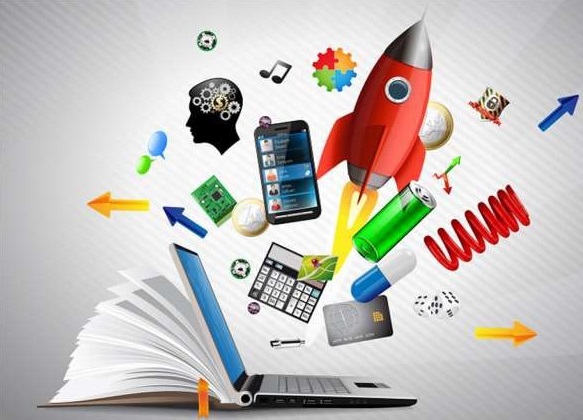
In the present world, if we think of any sort of development, then the presence of science and technology cannot be ignored.
What is Science?
Science fundamentally is the systematic study of the structure and behavior of the natural and physical world through observations and experiments.
Study of science evolved with the civilization of human beings.
What is Technology?
Technology (which is basically derived from the Greek word ‘technologia’) is an art, skill or ability, which is used to create and develop products and acquire knowledge.
Scientists used their knowledge to develop technology and then used technology to develop Science; so, because of this reason science and technology are an integrated term in today’s world.
Consider the following points to understand the relationship between Science and Technology −
- Contribution of Science to Technology
- Contribution of Technology to Science
Let us discuss these points in brief.
Contribution of Science to Technology
Let us now understand how Science has contributed to Technology −
Science as a direct source of new technological ideas
For example, innovation and development medical instruments; nuclear technology, radar system, etc.
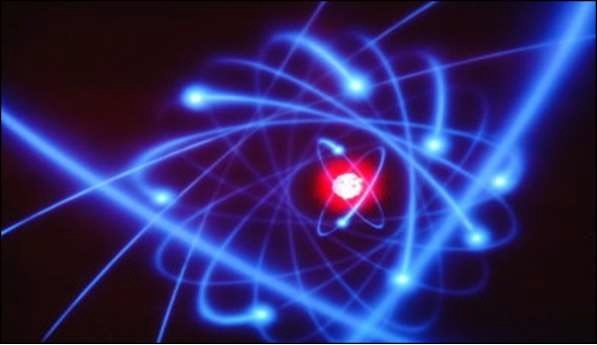
Science as a source of engineering
Most of the technical knowledge used in the designing and development of tools and techniques is actually an outcome of ‘engineering science’.

Science has also helped in the development of human skills. This is one of the fundamental contributions of Science.
Contribution of Technology to Science
Consider the following points to understand the contribution of Technology to Science −
Technology as a source of scientific challenges
The development in the field of technology paves way for research and development in the field of Science. For example, space science is one of them. Technological development likewise indirectly stimulates basic research in the field of science.
Instrumentation and measurement techniques
Development of advanced instruments facilitated scientists to measure the distance between sun and earth, the intensity of sun’s rays, the revolution of celestial bodies, internal problems of human beings, life of a bridge, etc.
Role of Science & Technology in Today’s Life
In today’s world, the role of science and technology is indispensable. We need Science and Technology in every sphere of our life like to treat diseases such as cancer or even to book a cab or train/flight ticket.
In fact, without technology (integrated with science), we cannot imagine our life per se.

One of the most important aspects of Science and Technology is that it has solution to the difficult of the difficult problems, the problems which have the potential to become major bottlenecks to the overall growth of the country. Some of these problems could be −
- Health aspects
- Standard of education
- Availability of healthy food and safe drinking water
- Infrastructure
On the other hand, once mitigating solutions are found for these problems, then the second major issue is the under-development in the field of scientific research and technology that directly affects the development of the country’s economy, infrastructure, higher education, and a few other fields listed below −
- Development of nuclear technology
- Defense technology
- Development of satellites
- Biotechnology
- Meteorological science
- Space technology
- Nanotechnology
- Wireless communication, etc.
All these technologies, in turn, provide favorable conditions for the country’s growth and increase healthy competition nationally and also internationally.
In today’s world, more often, we get to read or listen that developed countries, developing countries, underdeveloped countries, or even third-world countries, all these designate the level of development of Science and Technology in other countries, they have the influence on.
Government has also created an exclusive department to emphasize on the development of Science and Technology and a separate budget is also allocated for the same.
Nature of Science & Technology
Let us now discuss the nature of Science and Technology. There are normally two types of knowledge required for the overall development of a country −
Technical Knowledge
It can be defined in the simplest term as – ‘know-how’. It includes ranges of basic skills such as advancement in agriculture, development of chemical industries, medical technology, software engineering, etc.
Understanding of the attributes or elements
It means, knowledge and understanding of the intelligence of workers, quality of products, value of a firm, effectiveness of market, etc.
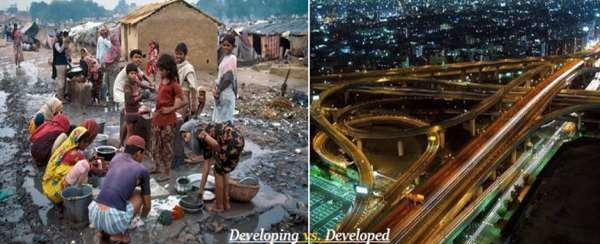
The uncompetitiveness of any of the attributes or elements leads to knowledge gap and information deficiency, which is directly related to the under-development of the respective country.
Likewise, Science and Technology is directly related to the overall development of the country. As a matter of fact, Science and Technology facilitates healthy competition between the different attributes and elements and acts like a platform for a better life.
Therefore, in order to alleviate the basic problems of food and supply, safe drinking water, health problems, education, infrastructure, etc., the emphasis and gradual development of Science and Technology is essential.
Role of Science & Technology In India
Over a period of time, India has progressively and perceptibly paved way for development in the field of Science and Technology.
The 21st century in India is apparently marked as the beginning towards an advancement in terms of technology and enrichment of knowledge base in the fields of Science.
At present, India holds a strong position in terms of advanced technology. India also serves as a knowledge warehouse with the existence of its many institutions catering to Science and Technology which come with qualified and trained manpower.
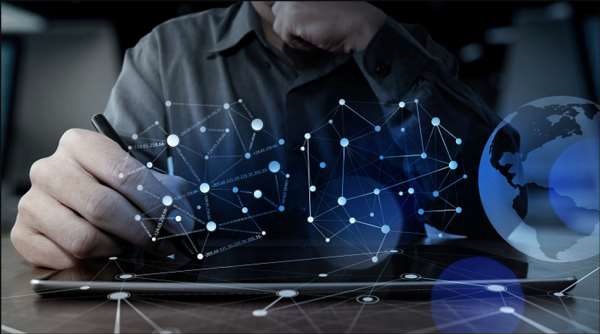
Areas of Development
Let us now discuss the different areas which undergo development with the advancement in Science and Technology −
Higher education
Scientific research and development
Technological development
Advancement of agricultural system
Development of space science and technology
Development of medical science and technology
Development of infrastructure
Information and communication technology
Development of various fields of engineering (including software, chemical, mechanical, civil, electrical, electronic, etc.)
Likewise, India has strong scientific and technological base that spreads across the country in the form of academic institutions, research and development laboratories, advanced medical center (with research facilities), experimental centers, and different advanced industries.
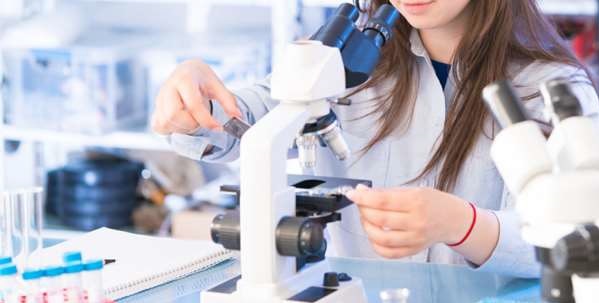
Because of the development in all spheres of Science and technology, today, India is unquestionably a leading developing country in the world.
Science & Technology and Industry in India
Over the recent past, Science and Technology has made tremendous contribution towards the settlement of industries in India.
Starting from the micro level to the macro level, research and development in the field of technology has created an ideal niche for the overall growth of the economic condition of the country. The perceptible examples are the development of Atomic Energy, Space Science, dozens of successful satellite systems, advanced medical technologies, etc.
After the independence, it was not possible for India to depend on other countries for various aspects of development; therefore, the development of indigenous technology was indispensable for the overall development of a country.
Thankfully, today, Indian technologies and companies are as competent as in other developed countries. India is also a lead in various fields, and is a tough competitor for other countries.
If we discuss about the skilled human resources, many Indians are at top-notch positions in leading companies.
Indian industries started flourishing post 1990, i.e., the landmark era. Globalization, liberalization, and privatization, facilitated this growth. The industries catering to Information & Technology, Atomic Energy, Automotive, Biotechnology, Nanotechnology, Pharmaceutical, Petroleum, etc. have increased at global level.
On the other hand, the Government of India has also made sizable investment in the field of research and development to encourage the advancement of Indian economy.
For consistent and efficient growth, various initiatives have been taken by establishing the following organizations −
- Council of Scientific and Industrial Research (CSIR) center
- Department of Science and Technology (DST)
- All India Institute of Medical Sciences (AIIMA)
- Aryabhatta Research Institute of Observational Sciences (ARIES)
- Central Drug Research Institute
- Centre for the Study of Developing Societies
- Central Electronics Engineering Research Institute
- Central Food Technological Research Institute
- Central Glass and Ceramic Research Institute (CGCRI)
- Central Institute of Agricultural Engineering
- Central Institute of Brackish Water Aquaculture
- Central Soil Salinity Research Institute
- Indian Institute of Engineering Science and Technology (IIEST)
- Indira Gandhi Centre for Atomic Research (IGCAR)
- Institute of Economic Growth
- Institute of Genomics and Integrative Biology (IGIB)
- National Institute of Electronics & Information Technology (NIELIT)
- National Institute of Pharmaceutical Education and Research
- National Institute of Oceanography (NIO)
Likewise, there are dozens of other such scientific research centers, which have been set up for the overall economic growth of the country.
Science & Technology and Society in India
The growth, peace, and security of a society is directly related to the development of the technology; as Science and Technology in a way influences the development as well as security of the society.

Consider the following points to understand how the security of a society is directly related to the development of the technology −
CCTV Camera at various locations (especially at public places) is one of the best examples of keeping crime under surveillance and it also provides a sense of security to the people.
Because of the advancement in technology, today, there is a reduce in communication gap; people have the information of where their near and dear ones are and are just a phone call away at times of need.
The job of the police has become easier, as police can trace criminals easily.
Besides, because of the advancement of technology, today, most of the villages in India have electricity, road, and can avail for essential facilities.
People, who are residing in even very remote part of the country, have the benefit of entertaining themselves and upgrading their knowledge through the different programmes broadcast on television (with dozens of channels).
Telecommunications network towers have been set up at the remotest of the remote regions too.
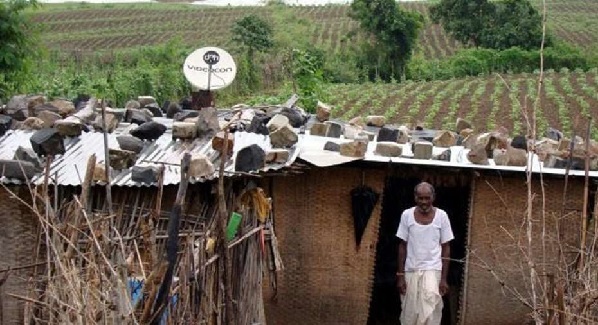
Therefore, Science and Technology is like a boon for the overall scientific and economic development of the country.
India: Development of Science & Technology
For the organized growth and development of Science and Technology in India, different specialized research and development agencies and organization are being set up.
Every organization specializes in a particular field to develop an advanced type of knowledge-based technology; for example, atomic industry is accountable to develop nuclear technology to fulfil the growing demands of energy.
Council of Scientific & Industrial Research (or CSIR) is a premier national Research & Development organization. CSIR is also accountable for the human resource development in the field of Science and Technology.
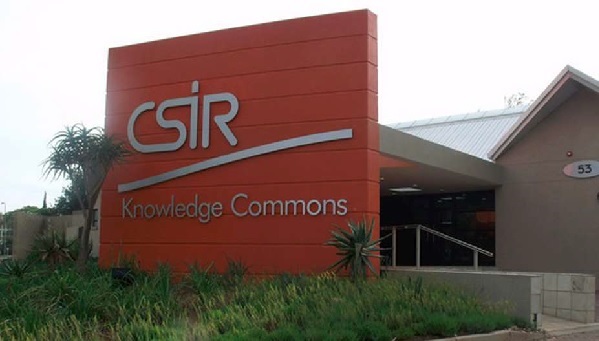
CAPART
During the seventh five-year plan (in 1986), the Council for Advancement of People’s Action and Rural Technology (CAPART) was established.
CAPART has been assigned with the task to catalyze and co-ordinate the emerging partnership between the Government and the voluntary organizations for sustainable development of rural areas.
Primarily, there were two organizations namely Council for Advancement of Rural Technology - CART and People’s Action for Development India - PADI; so, CAPART is a merger of these two organizations.
At present, CAPART is an autonomous body and is largely accountable for the rural development in India.
CAPART supports and promotes the voluntary organizations in planning and implementing the sustainable development projects especially in rural areas. The organizations also provides a platform for women, the physically challenged and disadvantaged groups to participate and promote the development.
Department of Science & Technology
The Department of Science & Technology (DST) plays a pivotal role in the promotion of science and technology in India.
DST has a huge responsibility; such as, at one end, it promotes high end research & development of cutting edge technologies; on the other hand, it provides technical skill sets and basic technologies to the common people.

Science & Technology Facts
Let us now discuss a few facts in the field of Science and technology.
At present, India is one of the most fascinating destinations for technology transactions in the world and it is ranked among the top five.
At present, about 27 satellites (out of which 11 facilitate the communication network to the country) are active and in operations.
Furthermore, India is ranked among the top ten nations in terms of the number of scientific publications.
As per the report of the National Association of Software and Services Companies (NASSCOM), the analytics industry of India is expected to touch about USD 16 billion by 2015 from the current USD 2 billion.
Very recently, with 1,000 MW capacity, the Kudankulam Nuclear Power Project Unit 1 (KKNPP 1) was set up.
The KKNPP I is located in Tirunelveli, Tamil Nadu.
To add to the existing project, with the same capacity (i.e. 1,000 MW), the Kudankulam Nuclear Power Project Unit 2 is under commissioning.
The DRDO, i.e., the Defense Research and Development Organization has tied up with Snecma, a French engine maker to develop the Gas Turbine and Research Establishment (GTRE); the GTRE will improve the performance of the Kaveri engines.
Kaveri engines are being used in ‘Teja’ the indigenous developed Light Combat Aircraft (LCA).
The Indian Space Research Organization (ISRO) has successfully completed its mission of developing India’s independent navigation system by launching the Indian Regional Navigation Satellite System (IRNSS – 1G).
IRNSS – 1G is the seventh navigation satellite and it will reduce the country’s dependency on US Global Positioning System.
India recently has become an Associate Member State of the European Organization for Nuclear Research (CERN); the motive is to increase the collaboration between India and CERN’s scientific and technological efforts and also promote the participation of Indian physicists, software engineers, and electronics hardware in global experiments.
The DHR (i.e. Department of Health Research), Ministry of Health and Family Welfare planned to set up a three-tier national network of Viral Research and Diagnostic Laboratories (VRDLs).
Under the project VRDLs, 160 VRDLs will be set up with the capacity to handle about 30 to 35 viruses of public health importance.
The Department of Biotechnology, Ministry of Science and Technology of the Government of India has now become the second country outside of Europe to have joined the European Molecular Biology Organization (EMBO).
Science & Technology Policy in India
The growth and development of Science and Technology in India is not a decade or a century old activity. There is evidence which shows that it is no less than an ancient saga; the growth and development is evident through the town planning, drainage system, road planning, etc. of the Indus Valley Civilization.
Likewise, throughout from the very ancient period to the medieval or to the modern, the planning and policy of Science and Technology are the major areas of emphasis.
However, after the independence, the five-year planning scheme commenced and over a period of time, Science and Technology accordingly became a major area of emphasis.
Pandit Jawaharlal Nehru, the first prime minister of India was the torchbearer who initiated by laying more emphasis on education and further led the foundation of Science and Technology.

Likewise, the first policy relating to Science and Technology was first introduced in 1958.
Over the recent past, India declared the decade 2010-2020 as the “Decade of Innovation.”
The Various Policies in The Field of Science and Technology
Let us now discuss the various policies implemented in the field of Science and Technology.
Scientific Policy Resolution of 1958
It was the first science policy that largely emphasized on basic research in almost every field of science.
The policy also put emphasis on developing and making available the basic infrastructure for the development of scientific research.
The Technology Policy Statement of 1983
The policy of 1983 was the second policy that largely focused on the achievement of technological competence and self-reliance.
The Science and Technology Policy of 2003
This policy brought the benefits of Science and Technology to the forefront and also focused on the investment required for research and development.
Further, it comes with integrated programs for the socio-economic sectors with the national research and development system to address the national problems and at the same time create a national innovation system.
Science Technology & Innovation Policy 2013
By 2013, Science, Technology and Innovation (STI) became the major drivers of national development.
This policy ensures faster, sustainable, and inclusive development of the people
Further, the policy focuses on the large demographic dividend and the huge talent pool to define the role in achieving the national goals.
The paradigm set by the policy of 2013 is “Science technology and innovation for the people.”
The key features of Policy 2013 are (source: Science, Technology and Innovation Policy 2013, Government of India, Ministry of Science and technology, New Delhi) −
Promoting the spread of scientific temper amongst all sections of society.
Enhancing skill for applications of science among the young from all social strata.
Making careers in Science, research and innovation attractive enough for talented and bright minds.
Establishing world class infrastructure for R&D for gaining global leadership in some select frontier areas of science.
Positioning India among the top five global scientific powers by 2020.
Linking contributions of science, research and innovation system with the inclusive economic growth agenda and combining priorities of excellence and relevance.
Creating an environment for enhanced Private Sector Participation in R&D
Enabling conversion of R&D outputs into societal and commercial applications by replicating hitherto successful models as well as establishing of new PPP structures.
Seeding S&T-based high-risk innovations through new mechanisms.
Fostering resource-optimized, cost-effective innovations across size and technology domains.
Triggering changes in the mindset and value systems to recognize, respect and reward performances which create wealth from S&T derived knowledge.
Creating a robust national innovation system.
Key Points of 12th Five-Year Plan (2012-17)
Besides the policies discussed above, the 12th Five-Year Plan (2012-17) focuses on the following points (of science and technology) −
Creation and development of national facilities in the field of R&D
Emphasis on partnership growth of Science and Technology
Large scale investment into mega science project aimed at the creation of the research and development infrastructure in India as well as abroad (under partnership)
NCSTC
National Council for Science & Technology Communication (NCSTC) emphasizes on the following key points −
Promote scientific thinking.
Promote and spread the significance of Science and Technology to masses nationally through different medium such as TV, digital media, print media, and people to people.
Emphasise on training in Science and Technology Communication.
Development and dissemination of Science and Technology software.
Focus on National Children’s Science Congress.
Likewise, through different plans and progressive policies, Science and Technology is being further developing in India.
Information Technology
21st century has come to be known as the era of Information Technology; it is the key driver of economic growth of not only a nation, but rather the whole world.
The growth and progress of every sector of the country today depends on the level of Information Technology.
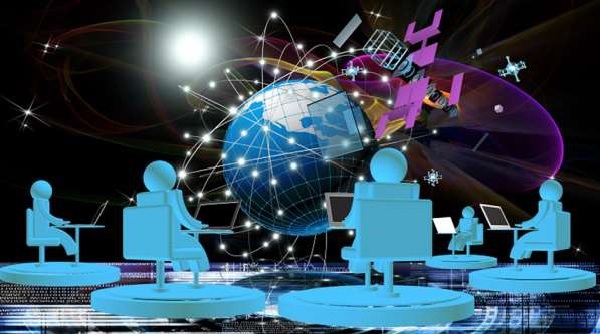
Furthermore, technology is not important only at the work place, but also in our everyday life; whether it is working with the microwave oven which is a cooking appliance or a super computer, an appliance is based on information technology, technology helps everywhere.
From hi-tech industry to an education system, Information Technology footprints can be seen everywhere.
Likewise, Information Technology is one of the essential features for the overall development of a country.
Meaning of Information Technology
The technology, which is exclusively designed to store, process, and transmit information, is known as Information Technology.
The following diagram illustrates the basic features and applications of Information Technology −
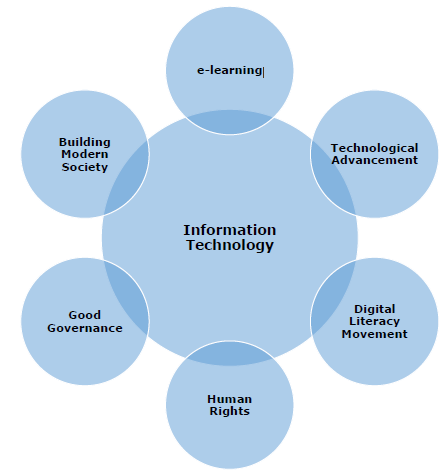
Though the diagram given above is not inclusive, as it does not include every aspect and application of information technology, but it comprehensively covers the major aspects.
Important Features of Information Technology
Following are the major features as well as advantages of Information Technology −
The development of Information Technology has made education system simpler, easier, and widespread. Now, people of remote areas can also use technology for their children’s education and also avail the benefits of adult education.
Diffusion of e-governance on a large scale.
Participation of public in governance and policy making.
Fast economic development.
Development of remote areas.
Technology helps the police in nabbing the criminals.
The judiciary and other administrative services can also take the help of technology to make work easier and faster.
Highly beneficial for the common people, as they can access their rights and can take legal action against the person who violates his/her rights.
It increases the happiness and prosperity of not only an individual, but rather the society as a whole.
Besides, there are many other advantages too that can be availed in our everyday life only with the further development of information technology.
Demerits of Information Technology
Information Technology is like a boon on the society. However, it comes with its own disadvantages −
As discussed above, with the help of technology, police can arrest criminals and criminal activities; at the same time, technology has also opened the door for criminals as well to practice smart criminal activity.
There are chances that children can misuse technology and take a wrong path.
Some distorted and perverted minds use technology to demean or defame someone unethically and also illegally.
These are basically not demerits but rather the misuse of technology.
Information Technology Act, 2000
By understanding the growing demand and applications of Information Technology, the Government of India passed the bill of Information Technology in 2000, which came to be known as the Information Technology Act, 2000.
The major features of the Act are −
It facilitates e-governance and e-commerce by providing equal legal treatment to users.
It made provision to accept electronic records and digital signature.
It gave legal approval to electronic business transactions.
The Act instructs banks to maintain electronic record and facilitate electronic fund transfer.
It also sets up a Cyber Law Appellate Tribunal.
Elements: Information Technology
In of our previous chapters, we discussed the meaning, benefits, and applications of Information Technology; in this chapter, we will discuss, the major elements, i.e., basically the core concept of Information Technology.
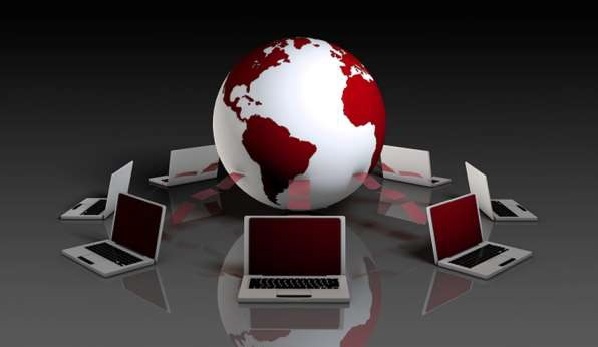
There are different subject matters those are being studied in the topic of information technology such as computer technology, electronics, IT industries, etc.
Areas Covered by Information Technology
Following are the essential topics of Information technology −
- Electronics
- Electronic Technology
Let us now discuss each area in brief.
Electronics
The purpose of using the term ‘electronics’ is to enumerate all those devices that we use in our everyday life, such as, watches, TVs, stereo systems, and many more (as shown in the image given below).
Further, the electronic devices are used in the design, manufacture, sale, and repair of all faulty products.

Because of the advancement in the field of technology, these days, it is possible to develop very small devices, such as small computer, small stereo system, etc.
The branch of electronics that does research on the miniaturization of electronic devices is known as ‘microelectronics.’
Following are some of the significant electronic devices that play a major role in different electronic products −
Semiconductor device
Largely made up of silicon, semiconductor is used in almost every electronic device.
Electron tube
It is normally a gas-filled tube in which the current of electrons flows between electrodes. However, when the gases are removed from the tube, it acts as a vacuum tube.
Analog device
It is a device that can measure, record, reproduce, or broadcast continuous information. For, example, radio waves used in the AM radio.
Digital device
It is a device that works on the sequence of pulse-like signals. The signals are coded to characterize numbers; for example, digital watches, computers, etc.
Electronic Technology
Following are a few important electronic technologies −
Golden-i
The Golden-i device consists of various mobile wireless wearable headset computers; the device is operated by voice commands and head movements (as shown in the image given below).

DNA Robot
It is a device that possibly can treat deadly diseases including cancer. The technology is being researched and developed.
e-Writer
It is a technology that translates handwriting into plain text on the screen. There is a different handwriting recognition software that senses handwriting and transfers the written text on the screen in the same format.

LCD
LCD stands for ‘liquid crystal display.’ This technology has two layers of polarized glass through which the liquid crystals block as well pass light. It uses fluorescent light. E.g. LCD TVs and Monitor.
LED
LED stands for ‘light emitting diodes.’ The LED technology uses light emitting diodes.
Encryption
It is a technique that converts information or data into a code, in order to prevent unauthorized access.
Other Important Areas Covered by Information Technology
We will now discuss the other important areas covered by Information Technology −
Telecommunication
It is the technology or process of communication over a distance by means of cable, telegraph, telephone, or broadcasting.
Fiber Optics
It is a technology that transmits signals on the principle of Total Internal Reflection (TIR) of light. The technology employs transmission of data in pulses of light form.
Integrated Service Digital Network (ISDN)
ISDN is a set of communication standards that simultaneously transmits voice, video, data, and other network services in digital form over the traditional circuits of the public switched telephone network.

Computer
A computer is a programmable electronic device that manipulates and manages different sorts of data and information.
A computer can store, process, and retrieve the save data.
Blue-Gene Computer
It is one of the fastest supercomputers developed by the IBM Crop.
Cloud Computing
Cloud computing is a technique of using a network of remote servers hosted on the Internet with the purpose to store, manage, and process data.
The technique keeps data safe and makes your data available anytime and anywhere; in other words, you don’t need to carry your computer device to carry data you access your data on any computer with internet facility.
Cyber Crime & Cyber Security
The crime that involves and uses computer devices and Internet, is known as cybercrime.
Cybercrime can be committed against an individual or a group; it can also be committed against government and private organizations. It may be intended to harm someone’s reputation, physical harm, or even mental harm.

Cybercrime can cause direct harm or indirect harm to whoever the victim is.
However, the largest threat of cybercrime is on the financial security of an individual as well as the government.
Cybercrime causes loss of billions of USD every year.
Types of Cybercrime
Let us now discuss the major types of cybercrime −
Hacking
It is an illegal practice by which a hacker breaches the computer’s security system of someone for personal interest.
Unwarranted mass-surveillance
Mass surveillance means surveillance of a substantial fraction of a group of people by the authority especially for the security purpose, but if someone does it for personal interest, it is considered as cybercrime.
Child pornography
It is one of the most heinous crimes that is brazenly practiced across the world. Children are sexually abused and videos are being made and uploaded on the Internet.
Child grooming
It is the practice of establishing an emotional connection with a child especially for the purpose of child-trafficking and child prostitution.
Copyright infringement
If someone infringes someone’s protected copyright without permission and publishes that with his own name, is known as copyright infringement.
Money laundering
Illegal possession of money by an individual or an organization is known as money laundering. It typically involves transfers of money through foreign banks and/or legitimate business. In other words, it is the practice of transforming illegitimately earned money into the legitimate financial system.
Cyber-extortion
When a hacker hacks someone’s email server, or computer system and demands money to reinstate the system, it is known as cyber-extortion.
Cyber-terrorism
Normally, when someone hacks government’s security system or intimidates government or such a big organization to advance his political or social objectives by invading the security system through computer networks, it is known as cyber-terrorism.
Cyber Security
Cyber security is a potential activity by which information and other communication systems are protected from and/or defended against the unauthorized use or modification or exploitation or even theft.
Likewise, cyber security is a well-designed technique to protect computers, networks, different programs, personal data, etc., from unauthorized access.
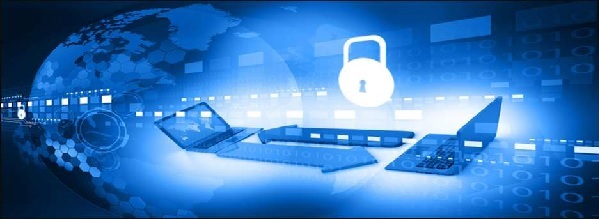
All sorts of data whether it is government, corporate, or personal need high security; however, some of the data, which belongs to the government defense system, banks, defense research and development organization, etc. are highly confidential and even small amount of negligence to these data may cause great damage to the whole nation. Therefore, such data need security at a very high level.
How to Secure Data?
Let us now discuss how to secure data. In order to make your security system strong, you need to pay attention to the following −
- Security Architecture
- Network Diagram
- Security Assessment Procedure
- Security Policies
- Risk Management Policy
- Backup and Restore Procedures
- Disaster Recovery Plan
- Risk Assessment Procedures
Once you have a complete blueprint of the points mentioned above, you can put better security system to your data and can also retrieve your data if something goes wrong.
E-Infrastructure in India
In today’s world, e-infrastructure is the key element for the development of a society.
E-infrastructure facilitates competent equipment and favorable resources and opportunities that are essentially needed to for the safety, security, and development of a society.
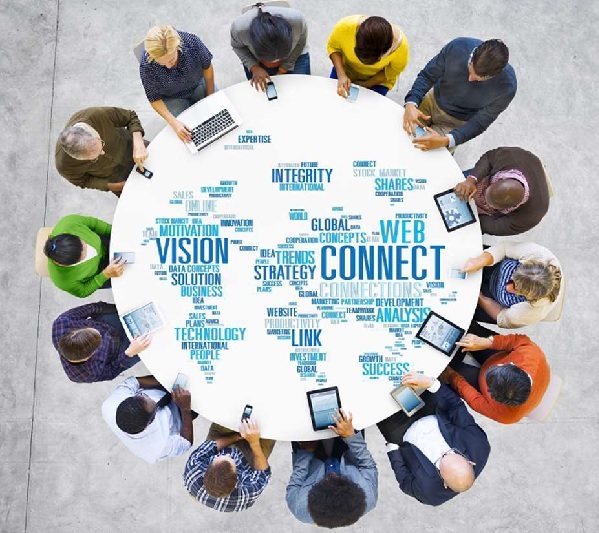
Further, e-infrastructure helps to integrate various technologies including different computer systems, internet broadband channels, computing power, data storage, data sharing, and many more.
To meet the growing challenges of globalization and also cope-up with the sustainable growth of information and communication technology, it is essentially required to integrate these systems by developing better e-infrastructure.
Initiatives
By understanding the growing demand and challenges, the Department of Information Technology formulated a ‘National Policy on Universal Electronic Accessibility’.
The policy was approved by the union cabinet in 2013.
The major strategies adopted in the implementation of the policy have been taken from the Press Information Bureau Government of India Cabinet October 3, 2013 −
Creating awareness on universal electronics accessibility and universal design.
Capacity building and infrastructure development.
Setting up of model electronics and ICTs centres for providing training and demonstration to special educators and physically as well as mentally challenged persons.
Conducting research and development, use of innovation, ideas, technology etc. whether indigenous or outsourced from abroad.
Developing programme and schemes with greater emphasis for differently abled women/children.
Developing procurement guidelines for electronics and ICTs for accessibility and assistive needs.
ITIR
For the exclusive growth of E-infrastructure in India, the Government of India has formulated the policy on ‘Information Technology Investment Regions (ITIRs) in 2008.
As per the policy, ITIRs will be self-contained integrated township with the purpose to accelerated growth of Information Technology, Information Technology Enabled Service, and Electronic Hardware Manufacturing units.
Further, the policy has recommended to assign minimum area of 40 sq. km for ITIR. However, out of the total demarcated area, 40% should be reserved for the processing zone and the remaining area for the non-processing zone.
The processing zone will include −
- Information Technology/Information Technology Enabled Services
- Electronic Hardware Manufacturing Units
- Logistics and other services and required infrastructure.
On the other hand, the non-processing area will include −
- Residential area
- Commercial area
- Other social and institutional infrastructure
National Knowledge Network
In 2009, in order to create an infrastructure that can fulfil the future requirements, the concept of ‘National Knowledge Network’ (NKN) is conceptualized.
The concept of NKN is designed to Encourage, Enable, Enrich, and Empower the user community to test and implement the innovative ideas without any restrictions.
Further, the NKN will provide better −
- Network design
- Security requirements
- Service requirements
- Operational requirements
Dot Bharat
The concept of developing the domain and website in ‘Devnagri’ (native script) was launched in August 2014.
This script will cover the following Indian languages −
- Hindi
- Marathi
- Boro
- Dogri
- Maithili
- Sindhi
- Gujarati
Gradually, other languages will also be covered.
Artificial Intelligence
Artificial Intelligence or simply AI is an experimental science being developed with the purpose to understand the nature of intelligent thought and subsequent action. It is presented by machines or software (computer).
In today’s context, largely, but of course not exclusively, Artificial Intelligence is related to Computer.
Therefore, study of AI also involves other disciplines including Psychology, Philosophy, Science, etc. (see the diagram given below) −
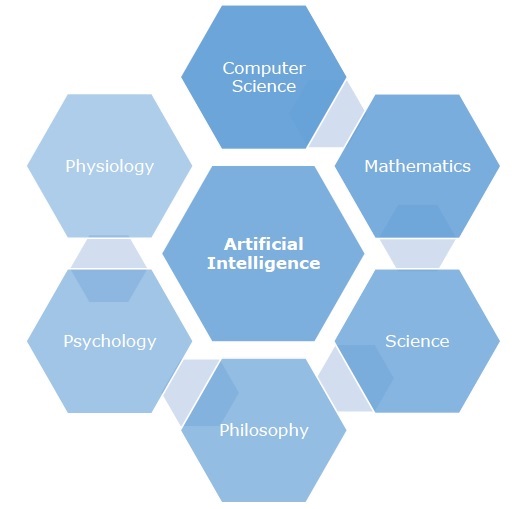
The conceptualization and progressive development of AI was started in 1940s; however, it was John McCarthy, a Stanford University researcher, who first coined this term.
John McCarthy is popular as the father of Artificial Intelligence.
Definition of Artificial Intelligence
Artificial Intelligence is a developmental science, and does not come with a complete definition; however, the definition given by Mr. McCarthy is still popular −
“An attempt will be made to find how to make machines use language, form abstractions and concepts, solve kinds of problems now reserved for humans, and improve themselves. We think that a significant advance can be made in one or more of these problems if a carefully selected group of scientists work on it together for a summer.”
Examples of AI
Following are a few examples of Artificial Intelligence in today’s world −
- Voice recognition by a computer system
- Image interpretation
- Face recognition
- Technology of biometrics
- Driverless vehicles
- Communication with machine, etc.
Applications of AI
In today’s technological world, AI is being applied in many different fields.
Application of AI Techniques in Network Intrusion Detection Intrusion Detection Systems (IDS) protects computer and communication networks from intruders. Following are the major areas where Artificial Intelligence is applied −
- Application of AI Techniques in Medical Field
- Application of AI Techniques in Accounting Databases
- Application of AI Techniques in the Computer Games
- Application of AI Techniques in enhancing the human intelligence, etc.
Data Mining
Data mining is an interdisciplinary branch of computer science, which involves a complex computing process and technique to discover the patterns in huge data sets.
It is a computing process that involves various methods along with machine learning, statistics, and database systems. Data mining helps in managing large databases.
Robot
Robot is an electromechanical technology (machine), which is programmed in such a way that it can perform a series of works automatically.

A robot can perform a variety of tasks, as programmed through the computer.
Areas of AI
Following are the major areas wherein, artificial intelligence is used −
- Understanding the language
- Problem solving
- Learning and adoptive system
- Visual perception
- Robots
- Modeling
- Games
Communication Technology
Communication is the exchange of information through different mediums.
It is an activity that started even before the civilization of human beings; however, over a period of time, as technology advanced, accordingly different modes of communications also developed including telecommunication and wireless communication.

In today’s world, information and communication technology play an important role in almost every activity that we perform.
Types of Communication
Based on the advancement and mode of technology, telecommunication is categorized as −
- Telecommunication
- Wireless Communication
Let us now discuss each category −
Telecommunication
Telecommunication is a technique of transmission of information from one location to another by electromagnetic means.
Different types of information can be transferred through a telecommunication system, such as voice, text, pictures, etc.
Modern Telecommunication System
The modern form of telecommunication involves computer technology and it is capable of transferring wide range of data including audio, video, textual, many other computer files.
Major components of modern telecommunication are −
Hardware − For example, computer system and modems.
Software − This controls the Computer programs.
Media − This is the communication outlet, wired or wireless.
Networking − This technology connects various computer systems.
Protocols − These rules govern information and communication transmission system.
Wireless Communication
Wireless communication is a technique of transmitting the information or power between two or more points, which are actually not connected with the physical wire/conductor.
The most common wireless technology uses ‘radio waves’. Microwave transmission is another technology.
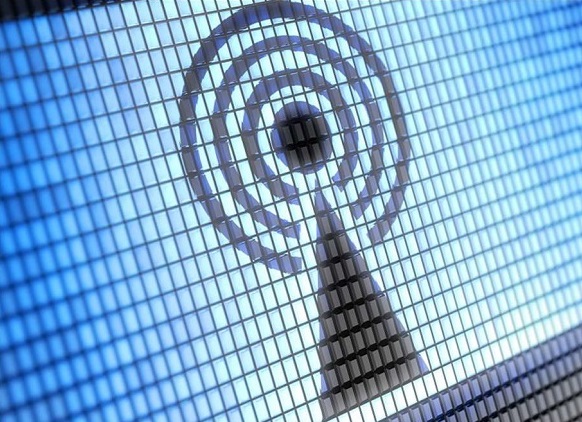
The world’s first wireless telephone communication took place in 1880. This was experimented by Alexander Graham Bell and Charles Summer Tainter. Both of them together invented and patented the ‘photophone.’
Photophone was a sort of telephone, which conducted audio conversations wirelessly over modulated light beams, i.e., electromagnetic waves.
However, in the 21st century, the invention of cellular phones radically changed the concept of communication system and made available the wireless communication system even in the remote part of the country.
Modulation
Modulation is one of the most significant processes through which characteristics of a carrier wave varies in accordance with an information signal.
In telecommunications, modulation is the process of transmitting a message signal inside another signal so that it can be physically transmitted. Likewise, modulation of a sine waveform transforms the narrow frequency range baseband message signal into the passband signal to pass through a filter.
Demodulation
Demodulation is the reverse process of modulation that change the signal and makes it understandable to the user.
Modulator
A modulator is a device that performs the modulation process.
Demodulator
Demodulator is a device that performs reverse modulation process or inverse of modulation.
Modem
Modem is device that performs both the process i.e. modulation and demodulation.
Types of Modulation
Let us now see what the different types of modulation are −
Analog Modulation
The waves continuously vary here and transfer signals; for example, audio signal, television signal, etc.
Digital Modulation
It remains in the form of discrete pulse, i.e., ‘on’ or ‘off.’ In this technology, all forms of data are used through binary digit, i.e., series of ‘0’ and ‘1.’
Methods of Modulation
In this section, we will see the different methods of modulation −
Amplitude modulation (AM)
In this method, the strength or intensity of the signal carrier varies. This represents that the data is being added to the signal.
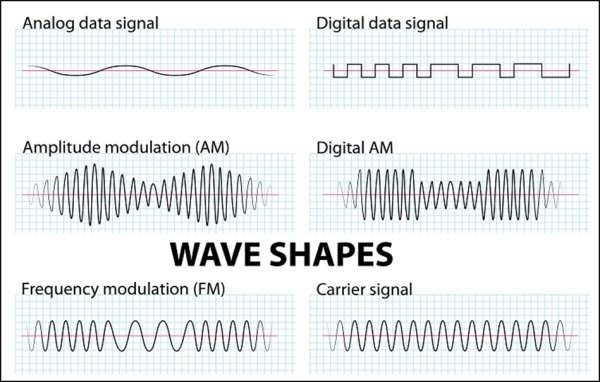
Frequency modulation (FM)
In this modulation, the frequency of the carrier waveform varies; this reflects the frequency of the data.
Phase modulation (PM) − It is somehow similar to FM, but not the same.

Space Science & Technology
In this chapter, we will discuss what is Space Science and how technology influences Space Science. We will focus more on the outer space, the outer space includes earth and all other planets, stars, galaxies, etc.
The outer space also contains low density of particles (largely a plasma of hydrogen and helium) and electromagnetic radiation, neutrinos, dust, cosmic rays, and magnetic fields.
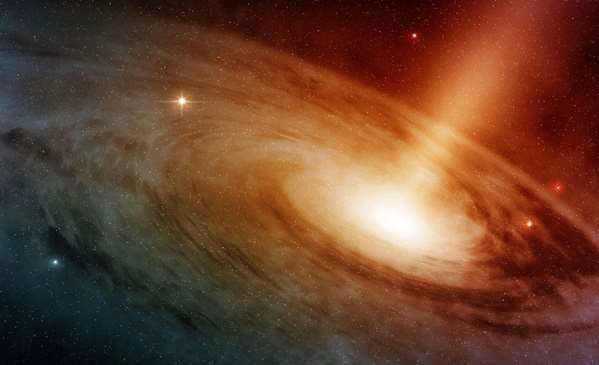
During the 20th century, human beings started the physical exploration of space with the help of high altitude balloon flights. Later, these balloon flights replaced by the advance technology, i.e., rocket, space shuttle, etc.
In 1961, the Russian scientist Yuri Gagarin attained a landmark achievement by sending an unmanned spacecraft to the outer space.
What is a Satellite?
Technically, satellite is an advanced technology (machine) launched into the space with the purpose to revolve around the earth and collected the targeted data.
Satellite has as such no specific shape; however, it has two essential parts −
Antenna − It sends and receives information.
Power source − It is either solar panel or battery that provides back up to the functionality of the satellite.

Types of Satellite
In this section, we will discuss the different types of Satellite. Depending upon the purpose, satellites can be categorized as follows −
Communication Satellite
It is designed largely for the purpose of communication. It contains the Transmitter and Responder; these instruments help in transmitting the data.
Earth Observation Satellite
This satellite helps in finding the earth’s resources, and also helps in disaster management, etc. So, it is basically a remote sensing satellite.
Navigation Satellite
Such satellite helps in navigation. So, it is basically a Global Positioning Satellite.
Weather Satellite
This satellite is exclusively designed for weather forecast. It has high resolution camera that takes picture of weather system and send.
Polar Sun-Synchronous Orbit
A Polar Sun-Synchronous Orbit, which is also known as a heliosynchronous orbit is a near polar orbit around the Earth where actually the satellite is placed.
The advantage of such orbital placement is that it has constant sunlight that ultimately helps in imaging, spying, and weather satellite.
The satellite in sun-synchronous orbit most likely ascends across the equator about twelve times a day; this happen each time at around 15:00 mean local time.
A polar sun-synchronous satellite is placed about an altitude of 600–800 km with periods in the 96-100-minute range. Such satellite remains inclined about 98.70. 90o represents a polar orbit and 0o represents an equatorial orbit.
Geosynchronous Orbits
A geosynchronous orbit has an orbital period, which matches the rotation rate of the Earth. One sidereal day is equal to 23 hours, 56 minutes, and 4 seconds.
Satellites in such orbit are typically launched in an eastward direction. To calculate the distance of a satellite in the geosynchronous orbit, the third law of Kepler is used.
Geostationary Orbit
Geostationary orbit is a specialized case of geosynchronous orbit. It is a circular geosynchronous orbit, which is inclined 0o to earth’s equatorial plane.
A satellite in a geostationary orbit always appears stationary, as it remains at the same point in the sky and observes the surface.
Astrobiology
Astrobiology is the branch of Science that studies the origin, evolution, and diffusion of life in the Universe. This concept was first explained by the Greek philosopher Anaxagoras during the 5th century BC. Later, during the 19th century, Lord Kelvin scientifically explained this term.
All these scientists attempted to prove that the life in universe begins from microbes.
Cryogenics
Cryogenics is the branch of natural science that studies various phenomena at very low temperatures. The literal meaning of cryogenics is – production of freezing cold.
Cryogenics has proven to be very useful for Superfluidity which is a highly beneficial property of liquid at cryogenic temperature, as it confronts the rules of surface tension and gravity.
Based on the principle of cryogenics, GSLV-D5 was successfully launched in January 2014. In GSLV-D5, cryogenic engine was used.
Biotechnology
Biotechnology is that branch of science which gained popularity in the 1970s. This is a Science which through different biological processes exploits organisms, cells, or/and cellular components to develop new technology.
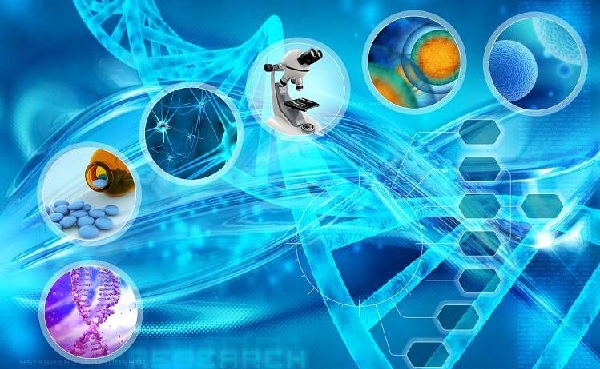
Biotechnology is proven to be very useful in the field of agriculture, medicine, industry, and environmental studies.
The Different Categories in Biotechnology
Let us now discuss the different categories in Bitechnology.
Red Biotechnology
This technology is used in the field of medicine to do research and develop new drugs. It makes use of stem cells to regenerate damaged human tissue.
Green Biotechnology
This technology is used in the field of agriculture to research and develop pest-resistant solutions. As part of Green Biotechnology, research activities are also done for disease-resistant animals.
White Biotechnology
This technology used in the field of industry to research and develop new chemicals or for the development of new fuels for vehicles.
Blue Biotechnology
This technology is used in the field of marine and aquatic environment to research and develop new techniques to control the proliferation of noxious water-borne organisms.
Deoxyribonucleic Acid
Deoxyribonucleic Acid or simply DNA is a micro element that specialized in carrying the genetic information in all cellular forms. As it is a natural polymer of nucleotide; therefore, it is known as polynucleotide.
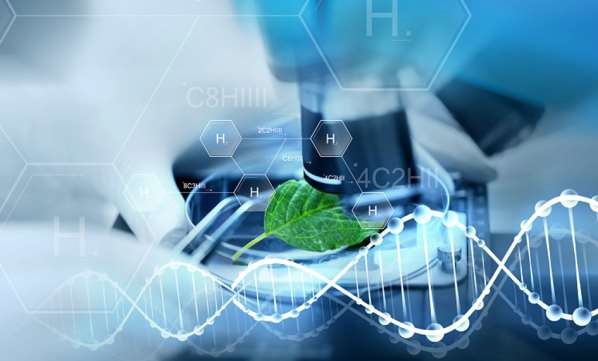
Most of the DNA molecules consist of two biopolymer strands, which remain coiled around each other and form a double helix structure (as shown in the image given above). DNA is a storehouse of biological information.
In 1869, DNA was first isolated by Friedrich Miescher; however, the molecular structure was first identified by James Watson and Francis Crick in 1953.
Application of DNA Science in Technology
Let us now discuss the fields where the DNA Science can be applied −
Genetic Engineering
The technology is used in developing genetically modified organisms, frequently used in agriculture.
DNA Profiling
This is done by forensic scientists; they take blood sample, semen, skin, body hair, saliva, etc. to identify people based on their DNA. This comes as great help in cases such as where the criminals need to be identified or the biological parentage of a child needs to be identified.
Bioinformatics
It is a technique to store, data mine, search, and manipulate biological data. It is largely applied in Computer Science. For example, it is used in string searching algorithms, machine learning, etc.
DNA Nanotechnology
This technology is used in molecular recognition, i.e., learning the properties of DNA and other nucleic acids.
Anthropology
DNA technology greatly helps anthropologists to understand the evolutionary history of organisms.
Ribonucleic Acid
Ribonucleic Acid or simply RNA is a nucleic acid that helps in coding, decoding, regulation, and expression of genes. Unlike DNA, RNA is found as a single-strand folded onto itself, rather than a paired double-strand (see the image given below – a comparative structure is shown).
Cellular organisms normally use messenger RNA, i.e., mRNA to convey genetic information.
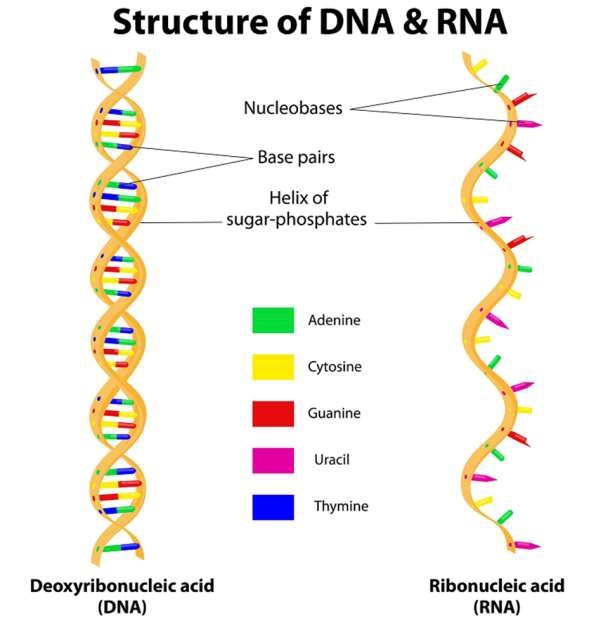
Nanotechnology
Nanotechnology or simply ‘nanotech’ is the engineering of matter on an atomic, molecular, and supramolecular scale. The credit of propagation of the concept of nanotechnology goes to Richard Feynman, the Nobel Prize Winner.
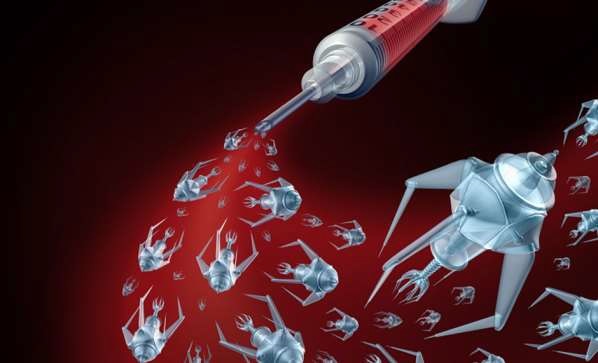
In his lecture, There’s Plenty of Room at the Bottom, Richard Feynman described the feasibility of synthesis through the direct manipulation of atoms. Further, Richard Feynman has written that −
“I want to build a billion tiny factories, models of each other, which are manufacturing simultaneously. . . The principles of physics, as far as I can see, do not speak against the possibility of maneuvering things atom by atom. It is not an attempt to violate any laws; it is something, in principle, that can be done; but in practice, it has not been done because we are too big.”
However, in 1974, Norio Taniguchi first used the term ‘nanotechnology’. One nanometer, i.e., nm is equal to one billionth, or 10−9meter. Likewise, if we compare, then it is a typical carbon-carbon bond length, or the spacing between these atoms in a molecule, which is in the range 0.12–0.15 nm.
Application of Nanotechnology in Different Fields
Let us now discuss the application of Nanotechnology in different fields.
Nanotechnology is used in the following fields of Science −
- Surface science
- Organic chemistry
- Molecular biology
- Semiconductor physics
- Microfabrication
- Molecular engineering, etc.
Nanotechnology is also used for the following purposes −
Making sunscreen and cosmetics
Packaging of food products (Silver nanoparticles is used in food packaging)
In clothing
In disinfectants and household appliances, e.g. Silver Nano
In carbon nanotubes (for stain-resistant textiles)
In treatment of disease and prevention of health issues (Nano-medicine)
In various industries
In purification processes
In environmental cleaning up applications
In desalination of water
In water filtration
In wastewater treatment
In groundwater treatment
Also used in military goods, Nano-machining of Nano-wires, construction materials, etc.
Terms Used in Nanotechnology
In terms of applications, following are the major terms used in the Science of Nanotechnology −
- Nano-medicine
- Nano-biotechnology
- Nanoart
- Green nanotechnology
- Industrial applications of nanotechnology
- Energy applications of nanotechnology
- Potential applications of carbon nanotubes
Ocean Technology
More than 70 percent of the Earth’s area is covered by water (water in Oceans) and it is a great source of energy – the next generations’ energy.
On the other hand, the resources on the land part is getting exhausted; therefore, the dependency towards oceanic resources is increased. So, in order to exploit the oceanic energy, advanced technology is being developed.

Types of Oceanic Resources
Following are the major types of oceanic resources −
Placer Minerals − It includes gold, diamond, platinum, tin, etc.
Granular Sediments − It includes carbonate rich sand, quartz and shell.
Hydrothermal Minerals − It includes copper, zinc, lead, etc.
Besides these minerals, an ocean is a storehouse of many other resources such sea food, oceanic wave energy, tidal energy, etc. In order to harness these resources, advanced technology is required which is now being developed.
Energy Harnessing Technology
Following are the different energies in the oceans that require technology for harnessing −
Ocean Thermal Energy
With the help of technology, energy is created from the warm water of the ocean. This technology is known as Ocean Thermal Energy Conversion or simply OTEC.
In OTEC, the water temperature difference is used to run turbine generator that ultimately produces electricity.
Such energy generation technology is environmental friendly and at the same time fulfills the energy requirement.
Tidal Energy
The rise and fall of sea water is largely because of gravitational force of sun, moon and earth, is known as tide.
The difference between the low and high tide is known as tidal range.
Technology has been developed to convert the tidal power into electricity.
In India, a tidal power plant has been set up at the Gulf of Kutch region (Gujarat).
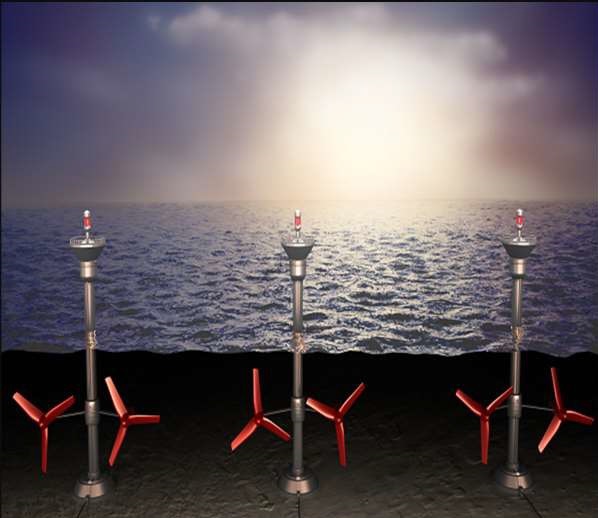
Wave Energy
Oceanic waves carry a lot of energy with them.
Different technologies are being used to convert oceanic wave energy into electricity.
However, the oceanic wave energy cannot be converted in electric energy, as it does not have that potential, but between 400 and 600 latitudes, wave energy can be harnessed.
Current Energy
The consistent movement of oceanic water in a particular direction, is known as oceanic current.
The above map shows different types of oceanic current.
Not all but some oceanic current are pretty capable of producing electric energy. For example, the Gulf Stream along the east coast of the United States.
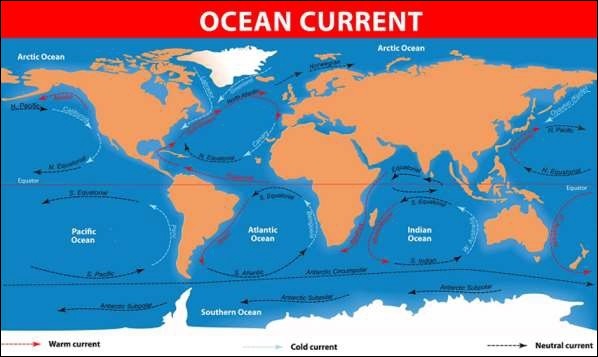
Specific technologies help in taping energy from oceanic current.
Nuclear Technology
The energy released by the change in the nucleus of atoms is known as nuclear energy. The changes in the nucleus of atoms is normally caused by either nuclear fusion or nuclear fission. The technology that manipulates such changes in nucleus (nuclear reaction) of some specific elements and transform into energy is known as nuclear technology.
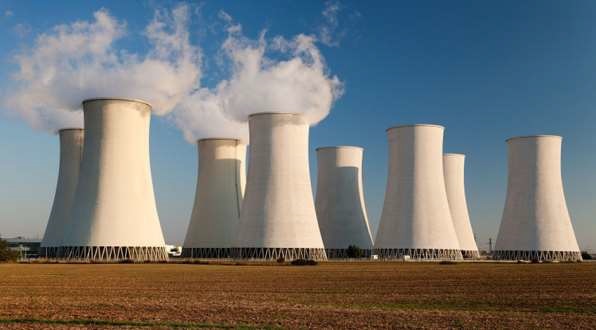
The energy released through the nuclear reaction is very high. For example, the fission of 1 kg of uranium-235 releases about 18.5 million kilowatt-hours heat.
Nuclear reactions naturally occur in chain reactions and hence keep releasing energy in continuity. In 1942, the Italian physicist Enrico Fermi first successfully produced the nuclear chain reaction.
What is Nuclear Fuel?
Nuclear fuel is the element that is used in nuclear power plants to produce heat to power the turbines.
Following are the major fuel elements −
- Uranium dioxide
- Plutonium
- Uranium nitride
- Uranium carbide
- Pressurized water reactor
- Boiling water reactors, etc.
Application of Nuclear Technology
Following are the areas where Nuclear Technology is applied −
Production of electric energy.
Nuclear technology is also used in different industries. For example, manufacturing of plastics and in the sterilization of disposable products.
Manufacturing of nuclear weapons for the defense forces of the country.
Medicinal use. For example, radiotherapy for the treatment of malignant tumors.
Frequently used in agricultural field to control pests, maximizing water resources, etc.
Used to reduce the environmental and health consequences of large-scale use of fossil fuels.
Advantages of Nuclear Energy Production
Following are the Advantages of Nuclear Energy Production −
Nuclear energy has the least impact on the environment, as it does not pollute air.
Nuclear plant does not require a very large area for setup.
Nuclear energy plant does not release greenhouse gases.
Once constructed and made it operative, its maintenance cost is much cheaper
Disadvantages of Nuclear Energy Production
Following are the Disadvantages of Nuclear Energy Production −
It is very expensive to set up a nuclear plant.
Different types of approvals are required including government’s approval.
Nuclear waste is very hazardous, as it remains radioactive for thousands of years.
Though it is rare, but nuclear accident is highly fatal. For example, the Chernobyl disaster (about 30 thousand people died).
Nuclear Power Around the World
Consider the following points to understand the position of Nuclear Energy around the world −
Nuclear energy is going to be the next super energy of the world because of its efficiency.
At present, not many, but about 31 countries are involved in developing nuclear energy.
There are about 440 nuclear reactors, which are producing energy for commercial purposes.
Nuclear energy provides about 14 percent of the world’s total electricity requirements.
The United States of America is the largest producer of nuclear energy, as it generates about one-third of world’s total and France is the second largest producer
In terms of percentage of share in total domestic electricity generation, France is the largest generator of nuclear energy.
In France, nuclear energy shares about 72 percent of the total domestic energy production.
Nuclear Energy in India
In this chapter, we will discuss Nuclear Energy in India.
Important Points About Nuclear Power in India
Consider the following points about Nuclear Power in India −
Nuclear power in India is the fourth-largest source of electricity after thermal, hydroelectric, and renewable sources (of electricity).
India has 22 nuclear reactors operating in 8 nuclear power plants.
The total installed capacity of nuclear power in India is 6780 MW. This produces 30,292.91 GWh of electricity.
6 reactors are under construction, which are expected to produce an additional 4,300 MW electricity.
The nuclear power plant of Jaitapur (located in Maharashtra) is planned to start in collaboration with France. It is a 9900 MW project.
The nuclear power plant of Kudankulam (located in Tamil Nadu) is an Indo-Russian collaboration. It is a 2000 MW project.
The Apsara nuclear research reactor was India's first nuclear reactor inaugurated in 1957. This was set up with assistance from the UK.
India's domestic uranium reserves are limited; hence, India imports uranium from Russia.
Some other countries with which India has uranium supply agreements are Argentina, Mongolia, Kazakhstan, and Namibia.
Furthermore, in 2011, the Atomic Minerals Directorate for Exploration and Research (AMD) of India has discovered large deposits of uranium in Tummalapalle belt located in Bhima River basin in Karnataka.
In this region, about 44,000 tonnes of natural uranium has been discovered.
Nuclear Power Plants in Operation
The following table lists down the functional nuclear power plants −
| Power Plant | Location | Total capacity (MW) | Operator |
|---|---|---|---|
| Rawatbhata | Rajasthan | 1,180 | NPCIL |
| Tarapur | Maharashtra | 1,400 | NPCIL |
| Kudankulam | Tamil Nadu | 2,000 | NPCIL |
| Kakrapar | Gujarat | 440 | NPCIL |
| Kalpakkam | Tamil Nadu | 440 | NPCIL |
| Narora | Uttar Pradesh | 440 | NPCIL |
| Kaiga | Karnataka | 880 | NPCIL |
Nuclear Power Plants Under Construction
The following table lists down the nuclear power plants, which are under construction −
| Power Plant | Location | Total capacity (MW) | Operator |
|---|---|---|---|
| Rajasthan Unit 7 & 8 | Rajasthan | 1,400 | NPCIL |
| Kakrapar Unit 3 & 4 | Gujarat | 1,400 | NPCIL |
| Madras (Kalpakkam) | Tamil Nadu | 500 | Bhavini |
| Kudankulam | Tamil Nadu | 2,000 | NPCIL |
Planned Nuclear Power Plants
The following table lists down the planned nuclear power plant projects −
| Power station | Location | Total capacity (MW) |
|---|---|---|
| Jaitapur | Maharashtra | 9,900 |
| Kovvada | Andhra Pradesh | 6,600 |
| t.b.d. (Mithi Virdi (Viradi)) | Gujarat | 6,600 |
| t.b.d. (Haripur) | West Bengal | 6,000 |
| Gorakhpur | Haryana | 2,800 |
| Bhimpur | Madhya Pradesh | 2,800 |
| Mahi Banswara | Rajasthan | 2,800 |
| Kaiga | Karnataka | 1,400 |
| Chutka | Madhya Pradesh | 1,400 |
| Madras | Tamil Nadu | 1,200 |
| Tarapur | Maharashtra | 300 |
Nuclear Energy By Country
Globally, there are about 31 countries in which nuclear power plants are functional. However, a few countries, such as France, Slovakia, Ukraine, Belgium, and Hungary use nuclear energy as the main source for a majority of the country's electricity supply.
A group of countries including Australia, Austria, Denmark, Italy, Greece, Portugal, Ireland, Latvia, Liechtenstein, Luxembourg, Malaysia, Malta, New Zealand, Norway, and Philippines have no nuclear power stations and they oppose such nuclear energy production.
The following table lists down the countries and the number of nuclear power plants in them −
| Country | Number of reactors | Generated electricity (GWh) | domestic generation share in % |
|---|---|---|---|
| Argentina | 3 | 7677.36 | 5.60% |
| Armenia | 1 | 2194.85 | 31.40% |
| Belgium | 7 | 41430.45 | 51.70% |
| Brazil | 2 | 14970.46 | 2.90% |
| Bulgaria | 2 | 15083.45 | 35% |
| Canada | 19 | 95650.19 | 15.60% |
| China Mainland | 36 | 197829.04 | 3.60% |
| Czech Republic | 6 | 22729.87 | 29.40% |
| Finland | 4 | 22280.1 | 33.70% |
| France | 58 | 386452.88 | 72.30% |
| Germany | 8 | 80069.61 | 13.10% |
| Hungary | 4 | 15183.01 | 51.30% |
| India | 22 | 35006.83 | 3.40% |
| Iran | 1 | 5923.97 | 2.10% |
| Japan | 43 | 17537.14 | 2.20% |
| Republic of Korea | 25 | 154306.65 | 30.30% |
| Netherlands | 1 | 3749.81 | 3.40% |
| Mexico | 2 | 10272.29 | 6.20% |
| Pakistan | 4 | 5438.9 | 4.40% |
| Romania | 2 | 10388.2 | 17.10% |
| Russia | 37 | 184054.09 | 17.10% |
| Slovakia | 4 | 13733.35 | 54.10% |
| Slovenia | 1 | 5431.27 | 35.20% |
| South Africa | 2 | 15209.47 | 6.60% |
| Spain | 7 | 56102.44 | 21.40% |
| Sweden | 10 | 60647.4 | 40.00% |
| Switzerland | 5 | 20303.12 | 34.40% |
| Taiwan | 6 | 30461.09 | 13.70% |
| Ukraine | 15 | 76077.79 | 52.30% |
| United Kingdom | 15 | 65148.98 | 20.40% |
| United States | 100 | 804872.94 | 19.70% |
| World total | 452 | 2,476 TWh | 10.9% |
India Nuclear Program
India’s first nuclear program started in 1967. On May 18, 1974, India conducted its first nuclear weapon test. The first fusion weapon test on May 13, 1998.
India has signed and ratified two treaties, i.e., Biological Weapons Convention and the Chemical Weapons Convention. India has also taken the membership of the Missile Technology Control Regime and is also a subscribing state to The Hague Code of Conduct.
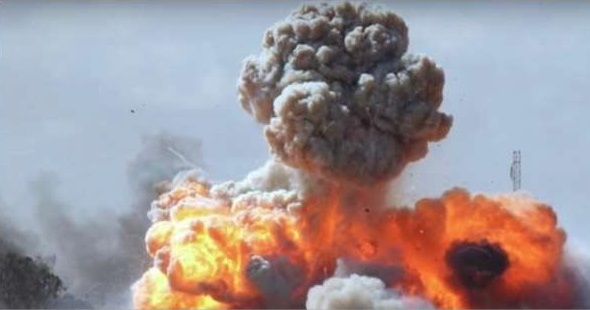
Biological Warfare of India
Consider the following points relating to the Biological Warfare of India.
India is one of the ratifying members of the Biological Weapons Convention (BWC) and it also pledged to abide by its obligations.
India possesses the scientific and technological capability to create a biological weapon, but there is as such no plan to do so.
In one of the speeches, the former President Dr. A. P. J. Abdul Kalam emphasized that "India will not make biological weapons, as is cruel to human beings".
Chemical Warfare of India
Consider the following points relating to the chemical warfare of India −
India is capable enough to produce chemical weapons, but it chooses not to do so.
India has signed and ratified the Chemical Weapons Convention (CWC), stating that it does not intend to manufacture chemical weapons.
In 1997, India had stock of chemical weapons, i.e., about 1045 tonnes of Sulphur mustard, but by the end of 2006, India has destroyed more than 70 percent of its stocked chemical materials and also promised to destroy the remaining.
Nuclear-armed Ballistic Missiles
The following table lists down the major nuclear-armed ballistic missiles of India −
| Name | Type | Maximum range (km) | Status |
|---|---|---|---|
| Prithvi-I | Short-range | 150 | Deployed |
| Prithvi-II | Short-range | 250 - 350 | |
| Prithvi-III | Short-range | 350 - 600 | |
| Agni-I | Short to medium-range | 700 - 1,250 | |
| Agni-II | Medium-range | 2,000 - 3,000 | |
| Agni-III | Intermediate-range | 3,500 - 5,000 | |
| Agni-IV | Intermediate-range | 4,000 | Tested successfully |
| Agni-V | Intermediate to Intercontinental-range | 5,000 - 8,000 | |
| Agni-VI | Submarine-launched with intercontinental-range (probable MIRV) | 6,000 | Under development |
| Agni-VI | Intercontinental-range (probable MIRV) | 8,000 - 12,000 | Under development |
| Surya | Submarine launched Intercontinentalrange MIRV | 10,000 | Yet to confirm |
| Surya | Intercontinental-range Multiple independently targetable reentry vehicle (MIRV) | 12,000 - 16,000 |
Sea-based Nuclear-Armed Ballistic Missiles
The following table lists down the major sea-based nuclear-armed ballistic missiles of India −
| Name | Type | Maximum range (km) | Status |
|---|---|---|---|
| Dhanush | Short-range | 350 | Inducted |
| Sagarika (K-15) | SLBM | 700 | Awaiting deployment on INS Arihant |
| K-4 | SLBM | 3,500 | Tested |
India Defence Technology
The responsibility of developing India’s defense technology is assigned to the DRDO, i.e., the Defence Research and Development Organization.
The Defence Research and Development Organization or DRDO was set up in 1958 and hence, it is the supreme body of researching, monitoring, regulating, and administering the India Defence Research and Development Program.
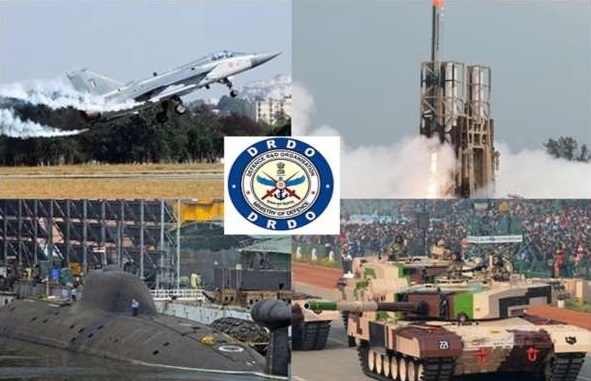
At present, DRDO is a network of more than 50 laboratories located in different cities of the country.
The DRDO specializes in the following fields −
- Aeronautical Engineering
- Electronics
- Armaments
- Engineering system
- Combat vehicles
- Missiles
- Advanced computing and simulation
- Life science
- Special materials
- Agriculture
- Training, etc.
Missile Technology
The development of missile technology in India started in the 1960s. Consider the following point relating to Missile Technology −
The first successful testing of space-cum-missile technology was the Rohini-75, which was tested in 1967.
The research and development program of developing indigenous missiles was called the Integrated Guided Missile Development Program’.
Types of Military Missiles
Based on target and launching position, the military missiles are classified as −
Air-to-Air Missile − This missile is carried by an aircraft and targets the enemy’s aircraft.
Surface-to-Air − Such missiles are fired at enemy’s aircraft from the ground.
Air-to-Surface − These missiles are fired at the enemy country’s ships, tankers, vehicles, bunkers, or military men from the aircraft.
Surface-to-Surface − Such missiles are fired at enemy grounds from our grounds.
Underwater − Such missiles target enemy locations in the water.
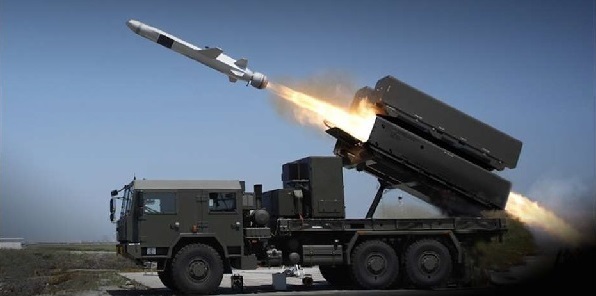
The Integrated Guided Missile Development Program
The idea of Integrated Guided Missile Development Program (IGMDP) was conceptualized by the former President and eminent scientist, Dr. APJ Abdul Kalam. The objective of this program was to enable India to attain self-sufficiency in the field of missile technology.
The missiles proposed under this program are −
Prithvi − It is a short-range surface-to-surface ballistic missile.
Trishul − It is a short-range surface-to-air missile.
Akash − It is a medium-range surface-to-air missile.
Nag − It is a third generation anti-tank missile.
Agni Series
Agni is a series of medium to intercontinental range ballistic missiles. Agni missiles are medium-to-long range, nuclear weapons capable surface to surface ballistic missile.
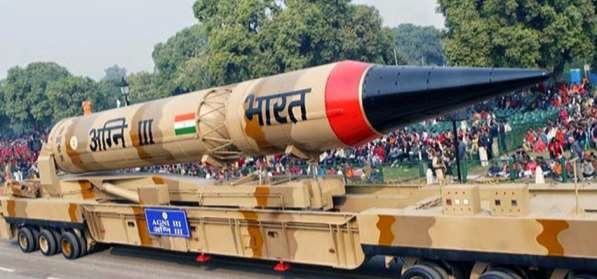
In the series of Agni missiles, the first (Agni-I) missile was developed under the Integrated Guided Missile Development Program in the 1980s and it was first tested in 1989.
The following table lists down the different Agni missiles with their features −
| Name | Type | Range | Status |
|---|---|---|---|
| Agni-I | Medium-range ballistic missile | 700 – 1,250 km | Operational |
| Agni-II | Medium-range ballistic missile | 2,000 – 3,000 km | Operational |
| Agni-III | Intermediate-range ballistic missile | 3,500 – 5,000 km | Operational |
| Agni-IV | Intermediate-range ballistic missile | 3,000 – 4,000 km | Operational |
| Agni-V | Intercontinental ballistic missile | 5,000 – 8,000 km | Testing |
| Agni-VI | Intercontinental ballistic missile | 8,000 – 10,000 km | Under development |
Space Exploration - Timeline
The following table lists down the major space missions along with their timelines −
| Mission | Year | Comment | Country |
|---|---|---|---|
| WAC Corporal | 1946 | It was the first (US designed) rocket that reached the edge of space. | USA |
| V-2 | 1946 | The first pictures of the Earth were taken from an altitude of 105 km. | USA |
| R-1 | 1951 | First time dogs were sent to space. | USSR |
| R-7 | 1957 | First intercontinental Ballistic Missile (ICBM) developed. | USSR |
| Sputnik 1 | 1957 | First artificial satellite. | USSR |
| Sputnik 2 | 1957 | First animal (dog named Laika) sent to the orbit. | USSR |
| Explorer 6 | 1959 | First photograph of Earth taken from the orbit (by NASA). | USA |
| Vostok I | 1961 | First manned flight carrying Yuri Gagarin | USSR |
| OSO-1 | 1962 | First orbital solar observatory (by NASA). | USA |
| Vostok 6 | 1963 | First woman in space (Valentina Tereshkova). | USSR |
| Luna 10 | 1966 | First artificial satellite around the Moon. | USSR |
| Apollo 8 | 1968 | First piloted orbital mission of Moon (by NASA). | USA |
| Apollo 11 | 1969 | First human on the Moon and first space launch from a celestial body (by NASA) - Commander Neil Armstrong and Pilot Buzz Aldrin. | USA |
| Luna 16 | 1970 | First automatic sample return from the Moon. | USSR |
| Salyut 1 | 1971 | First space station. | USSR |
| Pioneer 10 | 1972 | First human made object that had been sent on escape trajectory away from the Sun (by NASA). | USA |
| Mariner 10 | 1974 | First photograph of Venus from Space (by NASA). | USA |
| Venera 13 | 1982 | First Venus soil samples and sound recording of another world. | USSR |
| STS-41-B | 1984 | First untethered spacewalk, Bruce McCandless II (by NASA). | USA |
| Voyager 1 | 1990 | First photograph of the whole Solar System (by NASA). | USA |
| Mir | 1995 | First Record longest duration spaceflight (i.e. 437.7 days) set by Valeri Polyakov. | Russia |
| HALCA | 1997 | First orbital radio observatory. | Japan |
| NEAR Shoemaker | 2000 | First orbiting of an asteroid (433 Eros) – by NASA. | USA |
| NEAR Shoemaker | 2001 | First landing on an asteroid (433 Eros) – by NASA. | USA |
| Genesis | 2004 | First sample return beyond lunar orbit (solar wind)- by NASA. | USA |
| Cassini Huygens | 2005 | First soft landing on Titan (Moon of Saturn). | |
| Hayabusa | 2005 | First interplanetary escape without undercarriage cutoff. | Japan |
| Stardust | 2006 | First sample return from comet (81P/Wild) – by NASA. | USA |
| Kepler Mission | 2009 | First space telescope designated to search for Earth-like exoplanets – by NASA. | USA |
| MESSENGER | 2011 | First orbit of Mercury – by NASA. | USA |
| Voyager 1 | 2012 | First manmade probe in interstellar space – by NASA. | USA |
| Rosetta | 2014 | First man-made probe to make a planned and soft landing on a comet. | European Space Agency |
| 2015 | Lettuce was the first food eaten that was grown in space. | USA & Japan |
Satellites Launched by India
The following table lists down the major satellites launched by India −
| Mission | Launching Vehicle | Year | Discipline |
|---|---|---|---|
| Aryabhatta | Interkosmos-II | 1975 | Earth Sciences Space Physics |
| Bhaskara Sega-I | Modified SS-5 | 1979 | Astronomy, Communications, Engineering, Earth Sciences |
| Rohini RS-1 | SLV-3-E2 | 1980 | Earth Sciences |
| APPLE | Ariane-1 (V-3) | 1981 | Communications |
| Bhaskara -II | Modified SS-5 | 1981 | Engineering Earth Sciences |
| INSAT-1A | Delta 3910 PAM-D | 1982 | Communications |
| INSAT-1D | Delta 4925 | 1990 | Communications Earth Sciences |
| SROSS-C | ASLV-D3 | 1992 | Astronomy Earth Sciences Space Physics |
| IRS-P2 | PSLV-D2 | 1994 | Earth Sciences |
| IRS-1D | PSLV-C1 | 1997 | Earth Sciences |
| OceanSat-1 (IRS-P4) | PSLV-C2 | 1999 | Earth Sciences |
| INSAT-3B | Ariane-5G | 2000 | Communications |
| GSAT-1 (GramSat-1) | GSLV-D1 | 2001 | Communications Engineering |
| TES | PSLV-C3 | 2001 | Earth Sciences |
| Kalpana-1 (MetSat-1) | PSLV-C4 | 2002 | Earth Sciences |
| GSAT-2 (GramSat-2) | GSLV-D2 | 2003 | Communications |
| ResourceSat-1 (IRS-P6) | PSLV-C5 | 2003 | Earth Sciences |
| GSAT-3 (EduSat) | GSLV-F01 | 2004 | Communications |
| CartoSat-1 | PSLV-C6 | 2005 | Earth Sciences |
| HamSat | PSLV-C6 | 2005 | Communications |
| SRE-1 | PSLV-C7 | 2007 | Engineering |
| IMS-1 (Indian MiniSatellite-1 or, (Third World Satellite) | PSLV-C9 | 2008 | Earth Sciences |
| Chandrayaan-1 | PSLV-C11 | 2008 | Planetary Sciences |
| RISAT-2 | PSLV-C12 | 2009 | Earth Sciences |
| AnuSat-1 | PSLV-C12 | 2009 | Communications |
| OceanSat-2 | PSLV-C14 | 2009 | Earth Sciences |
| StudSat (STUDent SATellite) | PSLV-C15 | 2010 | Earth Sciences |
| ResourceSat-2 | PSLV-C16 | 2011 | Earth Sciences Technology Applications |
| YouthSat (IMS-2) | PSLV-C16 | 2011 | Solar Physics Space Physics |
| GSAT-8 (GramSat-8, or INSAT-4G) | Ariane-5 VA-202 | 2011 | Communications |
| Megha-Tropiques | PSLV-C18 | 2011 | Earth Sciences |
| Jugnu | PSLV-C18 | 2011 | Earth Sciences Technology Applications |
| SRMSat | PSLV-C18 | 2011 | Earth Sciences Technology Applications |
| SARAL | PSLV-C20 | 2013 | Earth Sciences |
| IRNSS-1A | PSLV-C22 | 2013 | Navigation/Global Positioning |
| Mars Orbiter Mission (MOM) (Mangalyaan-1) | PSLV-C25 | 2013 | Planetary Science |
| IRNSS-1B | PSLV-C24 | 2014 | Navigation/Global Positioning |
| GSAT-16 | Ariane-5 | 2014 | Communications |
| Astrosat | PSLV-C30 | 2015 | Space Sciences |
| GSAT-15 | Ariane 5 VA-227 | 2015 | Communications |
| IRNSS-1E | PSLV-C31 | 2016 | Navigation/Global Positioning |
| SathyabamaSat | PSLV-C34 | 2016 | Technology Applications |
| Swayam-1 | PSLV-C34 | 2016 | Communications Technology Applications |
| Pratham | PSLV-C35 | 2016 | Technology Applications |
| INS-1A (ISRO Nano-Satellite 1A) | PSLV-C37 | 2017 | Technology Applications |
Indian Space Research Organisations
The following table illustrates the major space research organizations of India −
| Research Organization | Location |
|---|---|
| Vikram Sarabhai Space Centre | Thiruvananthapuram (Kerala) |
| Liquid Propulsion Systems Centre | Thiruvananthapuram (Kerala) & Bengaluru (Karnataka) |
| Physical Research Laboratory | Ahmedabad (Gujarat) |
| Semi-Conductor Laboratory | Chandigarh |
| National Atmospheric Research Laboratory | Tirupati (Andhra Pradesh) |
| Space Applications Centre | Ahmedabad (Gujarat) |
| North-Eastern Space Applications Centre | Shillong (Meghalaya) |
| Construction and Launching Center | |
| ISRO Satellite Centre | Bengaluru (Karnataka) |
| Laboratory for Electro-Optics Systems | Bengaluru (Karnataka) |
| Satish Dhawan Space Centre | Sriharikota (Andhra Pradesh) |
| Thumba Equatorial Rocket Launching Station | Thiruvananthapuram (Kerala) |
| Human Resource Development Center | |
| Indian Institute of Remote Sensing (IIRS) | Dehradun (Uttarakhand) |
| Indian Institute of Space Science and Technology (IIST) | Thiruvananthapuram (Kerala) |
| Development and Educational Communication Unit | Ahmedabad (Gujarat) |
| Tracking and Control Facilities Center | |
| Indian Deep Space Network (IDSN) | Bengaluru (Karnataka) |
| National Remote Sensing Centre | Hyderabad (Telangana) |
| ISRO Telemetry, Tracking and Command Network | Bengaluru (Karnataka) |
| Master Control Facility | Bhopal (Madhya Pradesh) & Hassan (Karnataka) |
| Testing (Facility) Center | |
| ISRO Propulsion Complex | Mahendragiri (Tamil Nadu) |
| Other Centers | |
| Balasore Rocket Launching Station (BRLS) | Balasore (Odisha) |
| ISRO Inertial Systems Unit (IISU) | Thiruvananthapuram (Kerala) |
| Indian Regional Navigation Satellite System (IRNSS) | Byalalu (Karnataka) |
| Indian Space Science Data Center (ISSDC) | Bengaluru (Karnataka) |
Foreign Satellites Launched by India
The following table illustrates the major foreign satellites that launched by India −
| Satellite | Year | Launching Vehicle | Country |
|---|---|---|---|
| DLR-Tubsat | 1999 | PSLV-C2 | Germany |
| Kitsat-3 | 1999 | PSLV-C2 | South Korea |
| BIRD | 2001 | PSLV-C3 | Germany |
| PROBA | 2001 | PSLV –C3 | Belgium |
| Lapan - TUBsat | 2007 | PSLV-C7 | Indonesia |
| Pehuensat-1 | 2007 | PSLV-C7 | Argentina |
| AGILE | 2007 | PSLV-C8 | Italy |
| TecSAR | 2008 | PSLV-C10 | Israel |
| CAN-X2 | 2008 | PSLV-C9 | Canada |
| CUTE-1.7 | 2008 | PSLV-C9 | Japan |
| Delfi-C3 | 2008 | PSLV-C9 | Netherlands |
| AAUSAT-II | 2008 | PSLV-C9 | Denmark |
| COMPASS-1 | 2008 | PSLV-C9 | Germany |
| SEEDS-2 | 2008 | PSLV-C9 | Japan |
| NLS-5 | 2008 | PSLV-C9 | Canada |
| Rubin-8 | 2008 | PSLV-C9 | Germany |
| UWE-2 | 2009 | PSLV-C14 | Germany |
| BeeSat-1 | 2009 | PSLV-C14 | Germany |
| ITUpSAT1 | 2009 | PSLV-C14 | Turkey |
| SwissCube-1 | 2009 | PSLV-C14 | Switzerland |
| ALSAT-2A | 2010 | PSLV-C15 | Algeria |
| VESSELSAT-1 | 2011 | PSLV-C18 | Luxembourg |
| X-SAT | 2011 | PSLV-C16 | Singapore |
| SPOT-6 | 2012 | PSLV-C21 | France |
| PROITERES | 2012 | PSLV-C21 | Japan |
| SAPPHIRE | 2013 | PSLV-C20 | Canada |
| NEOSSAT | 2013 | PSLV-C20 | Canada |
| STRAND-1 | 2013 | PSLV-C20 | United Kingdom |
| AISAT | 2014 | PSLV-C23 | Germany |
| DMC3-1 | 2015 | PSLV-C28 | United Kingdom |
| LAPAN-A2 | 2015 | PSLV-C30 | Indonesia |
| Lemur-2-Peter | 2015 | PSLV-C30 | United States |
| TeLEOS-1 | 2015 | PSLV-C29 | Singapore |
| Galassia | 2015 | PSLV-C29 | Singapore |
| SkySat Gen2-1 | 2016 | PSLV-C34 | United States |
| 12 Dove Satellites | 2016 | PSLV-C34 | United States |
| Pathfinder-1 | 2016 | PSLV-C35 | United States |
| 88 Flock-3p satellites | 2017 | PSLV-C37 | United States |
| Al-Farabi-1 | 2017 | PSLV-C37 | Kazakhstan |
| PEASS | 2017 | PSLV-C37 | Belgium |
| Pegasus(QB50 AT03) | 2017 | PSLV-C38 | Austria |
| SUCHAI-1 | 2017 | PSLV-C38 | Chile |
| VZLUSAT-1 | 2017 | PSLV-C38 | Czech Republic |
| Aalto-1 | 2017 | PSLV-C38 | Finland |
| ROBUSTA-1B | 2017 | PSLV-C38 | France |
| URSAMAIOR | 2017 | PSLV-C38 | Italy |
| Max Valier | 2017 | PSLV-C38 | Italy |
| Venta-1 | 2017 | PSLV-C38 | Latvia |
| LituanicaSAT-2 | 2017 | PSLV-C38 | Lithuania |
| skCUBE | 2017 | PSLV-C38 | Slovakia |
| 3 Diamond Satellites | 2017 | PSLV-C38 | United Kingdom |
| CICERO-6 | 2017 | PSLV-C38 | USA |
Government Space Agencies
The following table lists down the major government space agencies of the world −
| Country/Region | Agency | Abbreviation |
|---|---|---|
| United States | National Aeronautics and Space Administration | NASA |
| Russia | Russian Federal Space Agency | RFSA |
| Russia | Roscosmos State Corporation for Space Activities | Roscosmos |
| Europe | European Space Agency | ESA |
| Japan | Japan Aerospace Exploration Agency | JAXA |
| France | Centre national d'études spatiales (National Centre for Space Studies) | CNES |
| Germany | Deutsches Zentrum für Luft- und Raumfahrt (German Aerospace Center) | DLR |
| Italy | Agenzia Spaziale Italiana (Italian Space Agency) | ASI |
| China | China National Space Administration | CNSA |
| India | Indian Space Research Organisation | ISRO |
| Canada | Canadian Space Agency | CSA |
| United Kingdom | UK Space Agency | UKSA |
| South Korea | Korea Aerospace Research Institute | KARI |
| Algeria | Algerian Space Agency | ASA |
| Ukraine | State Space Agency of Ukraine | SSAU |
| Argentina | Comisión Nacional de Actividades Espaciales | CoNAE |
| Iran | Iranian Space Agency and Iranian Space Research Center | ISA and ISRC |
| Spain | Instituto Nacional de Técnica Aeroespacial | INTA |
| Netherlands | Netherlands Space Office | NSO |
| Sweden | Swedish National Space Board | SNSB |
| Brazil | Agência Espacial Brasileira (Brazilian Space Agency) | AEB |
| Pakistan | Space and Upper Atmosphere Research Commission | SUPARCO |
| South Africa | South African National Space Agency | SANSA |
| Switzerland | Swiss Space Office | SSO |
| Mexico | Agencia Espacial Mexicana (Mexican Space Agency) | AEM |
| Belarus | Belarus Space Agency | BSA |
| Costa Rica | Asociación Centroamericana de Aeronáutica yel Espacio (Central American Association for Aeronautics and Space) | ACAE |
| International | Asia-Pacific Regional Space Agency Forum | APRSAF |
| Bahrain | Bahrain’s National Space Science Agency | NSSA |
| Venezuela | Agencia Bolivariana para Actividades Espaciales (Bolivarian Agency for Space Activities) | ABAE |
| Colombia | Comisión Colombiana del Espacio (Colombian Space Commission) | CCE |
| Singapore | Centre for Remote Imaging, Sensing and Processing | CRISP |
| Poland | Polska Agencja Kosmiczna (Polish Space Agency) | POLSA |
| United Nations | United Nations Office for Outer Space Affairs | UNOOSA |
Space agencies with human spaceflight capability
The following table lists down the different space agencies with human spaceflight capability −
| Country/Region | Agency | Abbreviation |
|---|---|---|
| United States | National Aeronautics and Space Administration | NASA |
| Russia | Roscosmos State Corporation for Space Activities | Roscosmos |
| China | China National Space Administration | CNSA |
The DRDO
The following table illustrates the major research centers of the Defence Research and Development Organisation (DRDO) −
| Laboratory Name | Area of Research | Location |
|---|---|---|
| Aerial Delivery Research & Development Establishment (ADRDE) | Parachutes & Aerial Systems | Agra |
| Vehicles Research & Development Establishment (VRDE) | Wheeled Vehicles | Ahmednagar |
| Naval Materials Research Laboratory (NMRL) | Naval Materials | Ambernath |
| Integrated Test Range (ITR) | Missile Testing | Balasore |
| Proof and Experimental Establishment (PXE) | Armament Testing | Balasore |
| Aeronautical Development Establishment (ADE) | Aeronautics | Bengaluru |
| Centre for Air Borne System (CABS) | Air-Borne Systems | Bengaluru |
| Centre for Artificial Intelligence & Robotics (CAIR) | Artificial Intelligence & Robotics | Bengaluru |
| Defence Avionics Research Establishment (DARE) | Avionics | Bengaluru |
| Defence Bio-engineering & Electromedical Laboratory (DEBEL) | Bio-engineering | Bengaluru |
| Gas Turbine Research Establishment (GTRE) | Gas Turbine | Bengaluru |
| Electronics & Radar Development Establishment (LRDE) | Radars | Bengaluru |
| Microwave Tube Research & Development Centre (MTRDC) | Microwave Devices | Bengaluru |
| Snow and Avalanche Study Establishment (SASE) | Snow and Avalanche | Chandigarh |
| Terminal Ballistics Research Laboratory (TBRL) | Ballistics | Chandigarh |
| Combat Vehicles Research & Development Establishment (CVRDE) | Combat Vehicles | Chennai |
| Defence Electronics Applications Laboratory (DEAL) | Electronics & Communication Systems | Dehradun |
| Instruments Research & Development Establishment (IRDE) | Electronics & Optical Systems | Dehradun |
| Centre for Fire, Explosives & Environment Safety (CFEES) | Explosives | Delhi |
| Defence Institute of Physiology & Allied Sciences (DIPAS) | Physiology | Delhi |
| Defence Institute of Psychological Research (DIPR) | Psychological Research | Delhi |
| Defence Terrain Research Laboratory (DTRL) | Terrain Research | Delhi |
| Institute of Nuclear Medicines & Allied Sciences (INMAS) | Nuclear Medicine | Delhi |
| Joint Cipher Bureau (JCB) | Cipher Systems | Delhi |
| Laser Science & Technology Centre (LASTEC) | Laser Technology | Delhi |
| Scientific Analysis Group (SAG) | Cryptology | Delhi |
| Solid State Physics Laboratory (SSPL) | Solid- State/ Semiconductor Materials | Delhi |
| Defence Research & Development Establishment (DRDE) | Chemical & Biological Warfare | Gwalior |
| Defence Institute of Bio-Energy Research (DIBER) | Bio-Energy | Haldwani |
| Advanced Numerical Research & Analysis Group (ANURAG) | Computational System | Hyderabad |
| Advanced Systems Laboratory (ASL) | Missiles & Strategic Systems | Hyderabad |
| Centre for High Energy Systems and Sciences (CHESS) | High Energy Weapons | Hyderabad |
| Defence Electronics Research Laboratory (DLRL) | Electronic Warfare | Hyderabad |
| Defence Metallurgical Research Laboratory (DMRL) | Metallurgy | Hyderabad |
| Defence Research & Development Laboratory (DRDL) | Missile & Strategic Systems | Hyderabad |
| Research Centre Imarat (RCI) | Missile & Strategic Systems | Hyderabad |
| Defence Laboratory (DL) | Camouflaging and Isotopes | Jodhpur |
| Defence Materials & Stores Research & Development Establishment (DMSRDE) | Textiles, Polymers & Composites | Kanpur |
| Naval Physical & Oceanographic Laboratory (NPOL) | Sonar Systems | Kochi |
| Defence Institute of High Altitude Research (DIHAR) | High Altitude Agroanimal Research | Leh |
| Defence Food Research Laboratory (DFRL) | Food Research | Mysore |
| Armaments Research & Development Establishment (ARDE) | Armaments | Pune |
| High Energy Materials Research Laboratory (HEMRL) | High Energy Materials | Pune |
| Research & Development Establishment (Engrs) (R&DE[E]) | Engineering Systems & Weapon Platforms | Pune |
| Defence Research Laboratory (DRL) | Health & Hygiene | Tezpur |
| Naval Science & Technological Laboratory (NSTL) | Underwater Weapons | Visakhapatnam |